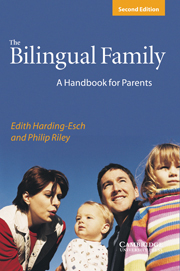Book contents
- Frontmatter
- Contents
- The authors
- Preface
- Part I A survey of the issues
- 1 Children and language
- 2 What is bilingualism?
- 3 Some things you should know about being bilingual
- 4 The development of the bilingual child
- 5 What will influence your decision whether to bring up your children as bilinguals?
- Part II Case studies: a number of bilingual families, and how they did it
- Part III An alphabetical reference guide
- Quotations
- Recommended resources
- Bibliography
- References
- Index
2 - What is bilingualism?
Published online by Cambridge University Press: 29 March 2010
- Frontmatter
- Contents
- The authors
- Preface
- Part I A survey of the issues
- 1 Children and language
- 2 What is bilingualism?
- 3 Some things you should know about being bilingual
- 4 The development of the bilingual child
- 5 What will influence your decision whether to bring up your children as bilinguals?
- Part II Case studies: a number of bilingual families, and how they did it
- Part III An alphabetical reference guide
- Quotations
- Recommended resources
- Bibliography
- References
- Index
Summary
Some definitions of bilingualism
If you ask people in the street what ‘bilingual’ means, they will almost certainly reply that it is being able to speak two languages ‘perfectly’. Unfortunately, we cannot even describe exactly what speaking one language perfectly involves. No one speaks the whole of the English language: for example, do you know what ‘stubs to can wall penetration welds’ are? Or what ‘tort’ is? Or a ‘treble top’? Probably not, unless you happen to be a welder, a lawyer or a darts player, and the chances of your being all three are almost non-existent. Each of us speaks part of our mother tongue. The bilingual does, too, that is, she speaks parts of two languages, and they very rarely coincide exactly. If she is a lawyer, for example, she may work only in English in her office or in court, but speak French at home, with the result that her legal English is far better (as such) than her legal French, and her domestic French is far better (as such) than her domestic English. How can we compare the two then? All we can say is that they are different tools for different purposes.
This problem, the fact that it is almost impossible to compare an individual's abilities in two different languages because we are not measuring the same things, is central to all discussion of bilingualism, and shows why the person in the street's ‘definition’ just will not do, except in very rare circumstances. It also explains why so many different definitions of bilingualism exist and why, though each may be a valid statement about one type of bilingualism, none is satisfactory or exhaustive.
- Type
- Chapter
- Information
- The Bilingual FamilyA Handbook for Parents, pp. 22 - 32Publisher: Cambridge University PressPrint publication year: 2003



